Putting the patient at the center requires understanding the whole person, not just his or her illness. Telling a patient’s story through his or her odyssey can be a powerful message.
By all accounts, mapping a patient journey is never a straight line leading from point A to point B, and requires an understanding that no two disease journeys are alike.
Drew Desjardins, executive VP, chief strategy officer, Dudnyk, says of course in each journey there are common elements such as information seeking, awareness, diagnosis, treatment, and adherence. “The way that patients, and often caregivers, go through these phases, however, can be circuitous, and the length of time they spend in each phase depends on a number of factors," he says. “These factors include demographics, psychographics, and technographics. But chief among these factors is psychographics or, more specifically, mindset."
Because not all patients experience a disease in the same way, understanding the patients’ near- 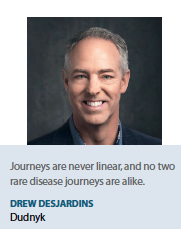 and long-term goals is paramount to understanding what the journey map looks like and where patients may fall along the path. “Typically, the final version of the map is quite different from our initial hypothesis," Mr. Desjardins says. “We find it very helpful to develop rich patient and caregiver personas built on deep understanding of behaviors, beliefs, and insights. By doing this exercise we often identify segments that were not obvious and that require special consideration for communication."
and long-term goals is paramount to understanding what the journey map looks like and where patients may fall along the path. “Typically, the final version of the map is quite different from our initial hypothesis," Mr. Desjardins says. “We find it very helpful to develop rich patient and caregiver personas built on deep understanding of behaviors, beliefs, and insights. By doing this exercise we often identify segments that were not obvious and that require special consideration for communication."
Mapping a patient’s journey with truth, empathy, and transparency can help make pharmaceutical brands matter when and where it counts the most and gives marketers a tool that shows how to best help patients, caregivers, and physicians attain the promise of better health, says Johanna Skilling, head of planning, Ogilvy Health.
Mapping a patient journey also has a tremendous effect on engagement and communications strategies. “Once we understand the patient mindset at each stage of the journey, and the decisions that patients must make when moving from one phase to the next, we can tailor communications to influence their decisions," Mr. Desjardins says.
Additionally, it is important to understand not only how a particular segment of patients behaves, but what is driving the behavior. “We ask questions such as, who is influencing their behavior?" he explains. “It could be a caregiver or perhaps a patient advocacy group. We also need to understand the information they are receiving from competitors and the effect it may have on decision-making. By overlaying the information ecosystem with the patient journey we 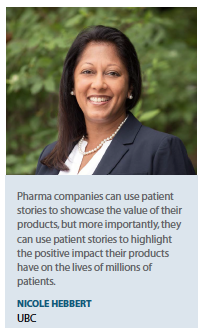 can enhance channel planning by syncing delivery of specific messages to points in the journey where they will have the best chance of changing behaviors. For example, we’ve had great success with this approach boosting opt-ins to CRM."
can enhance channel planning by syncing delivery of specific messages to points in the journey where they will have the best chance of changing behaviors. For example, we’ve had great success with this approach boosting opt-ins to CRM."
It’s easy to forget that patients and families embark on the disease journey not just unwillingly, but for most, for the first time, without a map of their own to guide them through the hazards and resources available. “Creating a deeply empathetic patient journey can clearly illustrate where and when pharma brands can matter most, providing welcome service and support at moments of need to patients, families and HCPs alike," Ms. Skilling says.
Mapping a patient journey is a multi-step, iterative process reliant on robust data, clinical expertise, and analytics, says Kara Dennis, senior VP and general manager, Clarify Health Solution. “The first step is to define the anchor codes for the journey in question — such as a specific procedure, diagnosis, or prescription — and the timeframe for analysis, which can range from a few days in the case of a course of antibiotics, to years for a disease such as diabetes," she says. “The next step is to identify clinically relevant claims to include in the analysis, which can be done bottom-up or top-down. Key metrics for analysis can then be defined. To do all of this, an expansive and longitudinal set of medical and pharmacy claims should be supplemented by other data, such as clinical data and social determinants of health. Especially for journeys that are complicated and/or less well understood, this process can be time consuming; tools such as AI and natural language processing can help to automate and make the process more scalable.
Monica St Claire, product lead, insights innovation, at Inspire, says without a doubt, patient stories are the most powerful and richest sources of real-world patient evidence and experience, able to seamlessly package and communicate actions, thoughts, feelings, and transport the audience into a different place, time, or life. “As humans, we’ve evolved telling and listening to narratives and this practice has made up the core of our ability to connect with and learn from others," she says.
The effectiveness of storytelling, from a linguistic and mechanical perspective, has to do with how efficient the narratives are at encoding contextual, behavioral, and emotional information into relatively brief communications that can capture weeks, months, or years. “A great example of this is a patient’s first and introductory post in an online healthcare forum: in a paragraph or two, patients typically tell the most relevant version of their story to orient the audience, making them able to provide appropriate help, information, and support," Ms. St Claire says. “These highly efficient, mini online journey posts usually start pre-diagnosis, touch on multiple medical 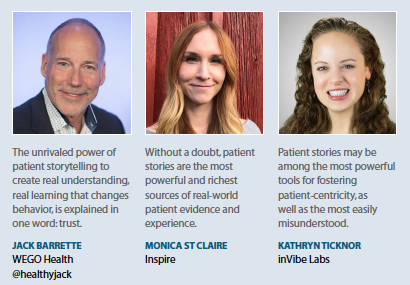 and treatments milestones, before ending up with a description of their current situation and their specific need and reason for posting within the forum. This all plays out over the course of sentences, not pages, and these types of informative narratives communicate not only what happened, but also, often, how the patient felt throughout it all."
and treatments milestones, before ending up with a description of their current situation and their specific need and reason for posting within the forum. This all plays out over the course of sentences, not pages, and these types of informative narratives communicate not only what happened, but also, often, how the patient felt throughout it all."
Harnessing the Power
“There is nothing in my mind more crucial to brand engagement than mapping a true patient journey; diving deep into the micro-moments to understand every behavior, feeling, and conversation," Ms. Skilling says. “This is not just for the patient, of course, but for her partner or family member, her HCP, even her community.
Ms. Dennis says a data-driven, rigorously mapped and intuitively visualized patient journey provides insight into how a given population interacts with the healthcare system and can provide a baseline of clinical and economic outcomes. “It also enables the creation of patient cohorts with differing characteristics and outcomes," she says. “These insights can be very actionable for providers and patients. For example, they can point to the need for education on health indicators that may warrant a different treatment pathway as well as payers, the net value of an intervention compared with the standard of care. We are already starting to see biopharma companies leverage a deeper understanding of patient journeys to refine their value messaging without the need for expensive and often underpowered postmarket studies, and over the next several years we expect this will continue to enable improved real-time risk stratification and clinical decision support.
Jack Barrette, CEO, WEGO Health, who established a network of patient influencers, clearly understands that the unrivaled power of patient storytelling to create real understanding is explained in one word: trust. “From newly diagnosed to life-long chronic illness patients, we recognize the authentic voice of a real patient," he says. “This genuine connection creates a bond of empathy."
The power of patient stories is inherently interactional, a contrast to the transactional dynamics of the intake form, exam room, or satisfaction survey. “When analyzing the messy data of natural language, meaningful patterns emerge," says Kathryn Ticknor, head of research, inVibe Labs.
“And by taking time to unpack patient stories, we move from anecdotal evidence to a framework for empathy.
It’s not enough to simply acknowledge the value of patient stories, Ms. Ticknor, says we have to learn how to truly listen. “To begin, it’s important to move beyond just hearing what a patient 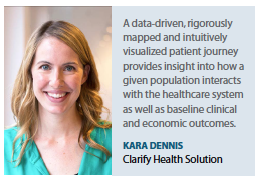 says; we need to consider how it is said and why. So we look for trends across groups of speakers to identify patterns in their experiences. For example, when we listened to stories told by patients with psoriasis, these narratives consistently showed low levels of urgency, signaled by verbs of uncertainty and paralinguistic cues, such as the tentative sound in their voices. These patients also created dramatic tension around the unresolvable nature of their symptoms and focused their narrative evaluations on what they could no longer do, conveying a sense of loss."
says; we need to consider how it is said and why. So we look for trends across groups of speakers to identify patterns in their experiences. For example, when we listened to stories told by patients with psoriasis, these narratives consistently showed low levels of urgency, signaled by verbs of uncertainty and paralinguistic cues, such as the tentative sound in their voices. These patients also created dramatic tension around the unresolvable nature of their symptoms and focused their narrative evaluations on what they could no longer do, conveying a sense of loss."
Bill Clark, senior director of community engagement, COPD Foundation, expresses the loss he felt after being diagnosed with COPD at 48. “I had been a teacher for 28 years, a Boy Scout leader, a night manager at a regional airport, and was just starting to plan the next chapter of my life: retirement and touring the country with my wife," he says. “Suddenly, all of that was taken away with a diagnosis of COPD and a life expectancy — if I was lucky — of six years. I didn’t handle it well. I bought cemetery plots, made a will, then sat and waited to die; after all, doctors are always right, aren’t they? One day, I got a call from one of my high school teachers and after telling him of all my preparations he asked me a question I had never considered: “are you ready to start living now?" That call began the changes I needed to make in my life because in truth I was so engrossed with the process of my impending death, I failed to realize that I had quit living. I became educated on my disease and I took greater control in how my disease was being managed. Shortly after, I received a call from John Walsh with the offer to help him form what is now the COPD Foundation. This began what has proven to be the most rewarding experience of my life. As a founding staff member, I have traveled the world, speaking to patients and professionals, sharing my story. I founded the COPD Information line and later COPD360social, an online social community for patients, caregivers, and professionals with more than 40,000 members. I am no longer a victim, but a part of the cure."
It has been 17 years since Mr. Clark’s diagnosis and he’s still here. Certainly his lung function has declined, and he has more bad breathing days than good ones, but he no longer dwells on that which he can’t control when there are so many things he can control. “I was once asked how long I could keep doing what and I am doing, and I replied: ‘I’m not dying today, not tomorrow, and not even for the next year because I’m booked solid.’ There is so much left to do."
WEGO Health has worked with hundreds of pharma brands to understand how patient leaders support and motivate their communities. “When we map patient journeys, we ask these leaders to tell us two to three stories of different patients at each stage of the journey — the barriers, the leaps forward, the loops backward — and how pharma can make that journey better," Mr. Barrett says.
This GPS of the patient journey is the currency of online patient communities — stories — and pharma has begun to embrace that authentic voice. Mr. Barrette cites the example of how GlaxoSmithKline’s Benlysta team collaborated with lupus patient leaders to fill gaps in the patient journey. “The leaders shared stories of patients’ challenges tracking their symptoms and treatments in a way that would inform their physician," he says. “GSK developed an unbranded  program — Us In Lupus — and followed patients’ recommendations to develop a patient resource kit. WEGO Health enlisted patient leaders to share the kit with their members on social media, through a paid video campaign that reached millions. Because it featured real patient leaders, the campaign generated signups at three times the rate of other promotions."
program — Us In Lupus — and followed patients’ recommendations to develop a patient resource kit. WEGO Health enlisted patient leaders to share the kit with their members on social media, through a paid video campaign that reached millions. Because it featured real patient leaders, the campaign generated signups at three times the rate of other promotions."
The pharma business cases for authentic storytelling are growing. Sage Therapeutics has a terrific program on postpartum depression that wouldn’t be possible without real moms. But just as compelling are the real human connections being made between people who work at pharma and patients — connections that may be pharma’s last best hope to build real patient trust.
Ms. Skilling offers another example involving the launch of the smoking cessation product Chantix. “Many are familiar with the introduction of Chantix, when Pfizer wisely chose to map the inner lives of would-be quitters long before they were ready to accept treatment," she says.
“By mapping the ideas, emotions, behaviors, and even the language of those who would — and would not — quit smoking successfully, Pfizer could deploy proven psychological principles in a carefully constructed program of education, support, and medication that has helped millions quit smoking for good. The content, channels, and cadence of this material came from analyzing the journey to determine what would be most motivating and supportive at each step in the road to success."
According to Usha Roy, senior director, patient services, Eversana, patients’ voices are critical and viewed as trusted sources of information by their peers. “Brands can leverage patient opinion leaders to get their message directly to other patients in meaningful ways, for example in branded materials for websites, television, podcasts, and social media," she says. “Patients’ voices can also be leveraged as part of the training provided to HCPs, sales teams, and other stakeholders. I have seen firsthand the positive impact of storytelling. We begin every team meeting with a patient story, we have caregivers present at our town halls and we celebrate patient successes and life events. I believe it is extremely important to keep patient stories as part of our daily thinking to always remember that we are working with real people."
Storytelling: Making a Meaningful Connection
Storytelling, or what some call developing the patient journey, is an effective way of communicating how patients feel and what they deal with on a day-to-day basis in managing their disease. For years, companies and brand teams have portrayed “patients" in their communications, but today real patients are asking for — even demanding — a realistic portrayal of what it means to be afflicted with a disease: the good, the bad, and the ugly.
Whitney Petit, an epilepsy patient and advocate, believes her story could change lives. “I want to tell my whole story — the ugly, messy, raw parts — not just the fluffy, pretty, two-minute clips you see on TV or in a social media ad," she says. “My story is about the long nights battling my condition and the amazing mornings, which give me a story to tell. I would tell it over and over if it meant helping someone fight and push through and make a difference."
Patient stories may be among the most powerful tools for fostering patient-centricity, as well as the most easily misunderstood, Ms. Ticknor says. “In a world where big data is king, we can be quick to dismiss storytelling under the label of anecdotal evidence and small sample sizes. Yet, as human beings, we are hardwired to respond to narratives at a deeper emotional level than we ever could to a series of numbers."
Nicole Hebbert, senior VP, head of patient support services, at UBC, a pharma company that engages with patients regularly, says companies can use patient stories to showcase the value of their products, but more importantly, they can use patient stories to highlight the positive impact their products have on the lives of millions of patients. “Using real-world patient stories brings forth the very human side of the often frowned upon prescription drug industry," she says. “But, beyond some positive brand equity, pharma companies can share the many ways that they deploy individualized patient-support programs. Patient stories bring those services to life by highlighting the complex worlds of drug coverage, product acquisition, and medication adherence. Sharing information about the roles and interactions with their reimbursement case managers, after-hours nursing support, and pharmacy partners, patient stories can be used to educate physicians, caregivers, and payers. One of the most inspiring ways that patients’ stories can be used is to drive patient-to-patient encouragement. It’s amazing the strength and care that very ill patients are still able to exude. Their stories are inspirational and they are brave and often willing to share their journey with others. Lastly, patient stories drive empathy. From the sales representative in the field, to the C-suite driving critical decisions, to the support services teams that have tactical goals to accomplish each day, patient stories remind all stakeholders of the value of the role they plan in the patients’ lives."
Jennifer Fillman, VP and general manager, specialty services, Cardinal Health Specialty Solutions, says to truly be patient-centered, brand teams need to understand the entirety of the situation a patient is facing, not just their disease. “There are many additional factors that can impact that patient’s well-being," she says. “Mapping the patient journey can help identify the potential obstacles that may impact a patient’s ability to receive the care his or her physician has prescribed and identify the best times to communicate and engage. For example, the manufacturer may want to reach out to the patient with a welcome call when they receive prior authorization. Nurses or other care navigators also can effectively engage with patients by helping to count down treatments that may have significant side effects. That nurse or navigator can then play a key role in identifying potential barriers to care, such as transportation or childcare needs, and help the patient make arrangements."
Bryan O’Malley of Fingerpaint, who is versed in interactive media, says creating immersive tools that illustrate the patient experience is a great way to build empathy with physicians. “It’s one thing to understand the clinical effects of a disease, but when we walk in the shoes of a patient struggling with a condition, the impact of the illness takes on a new meaning."
For example, he says, a Web utility that calculates the amount of disruption caused by the symptoms of a disease can help visualize the impact of an affliction. Shown over the course of a month, this can be a compelling way to illustrate the full extent of the challenges faced by the 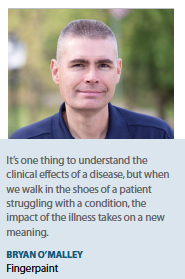 patient. “In a similar vein, an iPad game that demonstrates how dyslexia, paraphasia, and seizures make simple daily tasks like writing a grocery list nearly impossible can produce a much more compelling trade show experience than a simple testimonial video," Mr. O’Malley says.
patient. “In a similar vein, an iPad game that demonstrates how dyslexia, paraphasia, and seizures make simple daily tasks like writing a grocery list nearly impossible can produce a much more compelling trade show experience than a simple testimonial video," Mr. O’Malley says.
“Experiencing these patient realities — even in a virtual way — makes a lasting impression."
Ms. Hebbert cautions that just as patient stories vary, so do audiences, so it is critical to match the story to the audience. “A story of therapeutic success that resonates with a pharma company may not be the right story for a patient advocacy forum on reimbursement challenges," she says.
“Nor should all stories have happy endings. Storytellers need to be authentic and share a spectrum of outcomes. Some patients may have to start on an alternative therapy, or their coverage is denied after multiple payer appeals, but their resiliency is still a meaningful part of their story. Lastly, not everyone is a great storyteller. So much of a powerful story can be lost in the live delivery or format — digital, print, social media. The length and content must be tailored to maximize the impact."
Lynnette Cooke, global CEO of Kantar Health, says patient-centric means stepping into the shoes of the health consumer, and the industry will fall short of capturing the patient as a whole person if it doesn’t immerse itself in an organic and/or authentic way.
“There is one discussion in particular that made a profound impact on how I think about people and their health," she recalls. “We were dining during one of our informal friends and family sessions, where we gather in small groups to learn more about one another. That day, my colleague and I were speaking to the husband of a patient who had been recently diagnosed with MS. While his wife was dining at a nearby table, we kept openly referring to him as a caregiver — her caregiver. After he became more comfortable talking to us, he leaned in and whispered so his wife couldn’t hear him, and said: ‘She doesn’t like it when people call me her caregiver. It’s hard enough to accept that she will die from this and that one day she won’t be able to walk on her own. I’m her husband. To call me her caregiver makes her feel depressed."
Lesson learned.
~~~~~~~~~~~~~~~~~~~~~~~~~
From Child’s Play to 4-Level Chess: Mapping a Human Journey
Johanna Skilling
Head of Planning
Ogilvy Health
First, get a great, multi-functional team together for an hour or two (two is better). Make sure you’ve got a room with a big, clean whiteboard or a long sheet of printer paper for drawing with abandon. Have lots of colorful markers and sticky pads.
Start by drawing the broad steps, from family history to symptoms, to every interaction with HCPs, all the way to treatment and brand acceptance and adherence. And maybe add a few more steps unique to the disease you’re dealing with. A bit of advice: start your drawing high on the paper. You’ll need the space below.
Now ask your team to identify what happens at each stage, for each stakeholder: every decision, every action, non-action, feeling, question or conversation. When you’re done, you should have a messy, colorful, intricate, multi-layered map. Then find the best designer you have, and graphically unpack the strands of each stakeholder’s individual path: patient, family member, HCP, payer. Identify dominant actions, thoughts, feelings, questions. Your 4-dimensional chess game will begin to unfold.
Validate your work with research. Find out where those stakeholders get information, and through which channels. Learn what motivates them and what turns them off. Figure out what competitors are saying, to whom, and when. Develop messages, concepts, and experiences that you can test to determine real-life reactions in market. And then it will be clear to you not just where your brand can matter most — but why.
~~~~~~~~~~~~~~~~~~~~~~~~~
Patients’ Voices
Hope Aguilar
Ovarian Cancer Research Alliance & National Ovarian Cancer Coalition
@HOPEthrucancer
I would like my story to be communicated in all ways, whether in writing or an interview on the radio or on television. It’s about getting the story out there, to give attention to the need for more ovarian cancer awareness. I am open and honest about everything I went going through. It’s about being transparent to the nurses and doctors. Not holding anything back. Because as great as medical professionals can be, they are not perfect and when it comes to ovarian cancer, medical professionals miss stuff. So, along with being transparent when talking about my medical problem, I learned that in many ways we, patients, have to be our own doctors.
Meaning, we have to do our own research, through Internet searches and by looking at discussion boards of other patients/survivors, and communicate what we find to the medical staff. It doesn’t make us more knowledgeable than nurses or physicians, but it can help us know how to describe what we are feeling or to not let a physician dismiss any of our concerns.
I would like to let other patients know that they are not alone. That there is hope. Hope that there can be life after cancer — regardless of the stage they are diagnosed at. And that cancer doesn’t have to mean the end.
John-Manuel Andriote
HIV and Mental Health Advocate
@jmandriote
I have never believed HIV was a moral issue; it is merely a microbe that happens to be most easily transmitted among humans through sex or needle sharing. But people attach negative meaning to things they fear, and the rampant fear about HIV/AIDS in the 1980s gave rise to the stigma so many still attach to this particular microbe — despite massive advances in prevention and treatment. When I was diagnosed with HIV in 2005, three weeks after my 47th birthday, I said to my doctor: “Now I will have to live out all the things I’ve professed to believe about HIV."
Because I don’t believe that having HIV is immoral or shameful, I don’t turn the stigma inward upon myself. I accept it as an unfortunate fact of my life. I know that too many folks living with HIV turn the stigma upon themselves. It can lead them to depression, substance overuse, or not taking their medications as prescribed.
My experience, strength, and hope can help others living with HIV — or other chronic conditions — to reject stigma, and to focus instead on the courage and resilience they have demonstrated in their lives simply by getting this far. I try to help them look at their own life story, and recognize the “heroic journey" they have been on.
Brooke Gant
Clear Cell Ovarian Cancer
@BGant21
I am not just a patient, I am also a survivor and warrior. I was diagnosed with ovarian cancer at 32 years old, and I struggled a lot with losing my fertility. I felt so much of my worth was wrapped up in being able to have children, which I believe is common with young women who suffer from infertility. I would like other women dealing with this issue to know that their emotions are valid, but that they are in no way broken or alone, as I felt. I found it very helpful to speak with others who have faced the same hardships. In doing so, I have come to realize that your worth is not wrapped up in whether you can bear your own children, and that it’s not the only way to make a difference in the world. Live a life filled with love, patience, and giving back to important causes, which are all wonderful ways to leave your mark on the world.
Barbara Jacoby
CEO and Founder, Let Life Happen
@letlifehappen.com
Each patient’s journey or story is as individual as his or her fingerprints. I do not use my story or that of anyone else in my communications. The main reason is that it sets the stage for judgment and comparisons and “experts" in giving advice to others when another person’s experiences most often are entirely different. And patients often experience enough guilt about their situation that can be further advanced if they don’t measure up to someone else’s handling of a similar disease.
Megan Starshak
Co-Founder, Creative, Patient
The Great Bowel Movement
Inflammatory Bowel Disease (Crohn’s and Colitis)
@thegreatbm
My story is my evolution from feeling angry and out of control, to finding my voice, using my voice, and feeling as if I can’t waste my experience and opportunity. It’s more of an emotional journey, but an important one. Connecting with other people — patients who get it — is the most important thing I could have done. I would other patients to know they are allowed to be angry, but don’t let anger prevent you from learning from it. I would like patients to recognize their own power to influence positive change, whether it’s just for one other person, for the community at large, or even within themselves.
My story is my evolution from feeling angry and out of control, to finding my voice, using my voice, and feeling as if I can’t waste my experience and opportunity. It’s more of an emotional journey, but an important one. Connecting with other people — patients who get it — is the most important thing I could have done. I would other patients to know they are allowed to be angry, but don’t let anger prevent you from learning from it. I would like patients to recognize their own power to influence positive change, whether it’s just for one other person, for the community at large, or even within themselves.



















